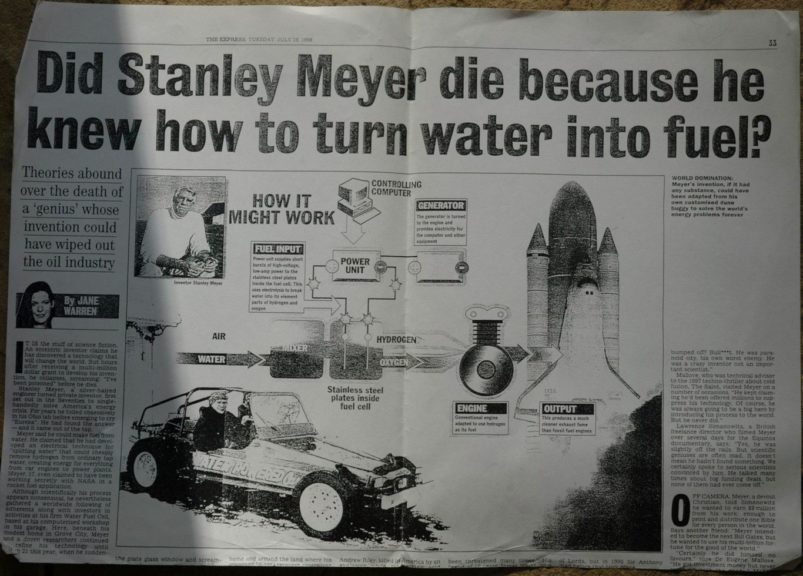
Meyer thought that the way to get out of oil dependency was through water propulsion. Yes, water. A “very” alternative solution, it goes without saying.
He created a fuel cell, based on the principle of splitting water atoms into its elemental form, burning hydrogen to create energy and releasing oxygen, along with water residues, through the exhaust pipe, thus generating harmless emissions.
After a few months he managed to develop his water-powered engine, mounting it onto a dune buggy painted with the conspicuous writing: “water powered car”, and with a call to his Christian faith, to communicate the spirit of protection and creation, which animated his actions.
Meyer claimed his vehicle was able to travel 180 km. With just 4 litres of water, and nothing else. Forty-five kilometres with just a litre of something that cost hardly anything must have sounded truly magical. And that’s exactly when his troubles started.
In a news report on an Ohio TV station, Meyer demonstrated a dune buggy he claimed was powered by his water fuel cell. He stated that only 22 US gallons (83 liters) of water were required to travel from Los Angeles to New York. Furthermore, Meyer claimed to have replaced the spark plugs with "injectors" that introduced a hydrogen/oxygen mixture into the engine cylinders. The water was subjected to an electrical resonance that dissociated it into its basic atomic make-up. The water fuel cell would split the water into hydrogen and oxygen gas, which would then be combusted back into water vapor in a conventional internal combustion engine to produce net energy.
Philip Ball, writing in academic journal Nature, characterized Meyer's claims as pseudoscience, noting that "It's not easy to establish how Meyer's car was meant to work, except that it involved a fuel cell that was able to split water using less energy than was released by recombination of the elements ... Crusaders against pseudoscience can rant and rave as much as they like, but in the end they might as well accept that the myth of water as a fuel is never going to go away."
To date, no peer reviewed studies of Meyer's devices have been published in the scientific literature. An article in journal Nature described Meyer's claims as one more "water as fuel" myth.
Stanley Meyer's invention was later termed fraudulent after two investors to whom he had sold dealerships offering the right to do business in Water Fuel Cell technology sued him in 1996. His car was due to be examined by the expert witness Michael Laughton, Professor of Electrical Engineering at Queen Mary University of London and Fellow of the Royal Academy of Engineering. However, Meyer made what Professor Laughton considered a "lame excuse" on the days of examination and did not allow the test to proceed. His "water fuel cell" was later examined by three expert witnesses in court who found that there "was nothing revolutionary about the cell at all and that it was simply using conventional electrolysis." The court found Meyer had committed "gross and egregious fraud" and ordered him to repay the two investors their $25,000.
Stanley Meyer died suddenly on March 20, 1998, while dining at a restaurant. His brother claimed that during a meeting with two Belgian investors in a restaurant, Meyer suddenly ran outside, saying "They poisoned me". After an investigation, the Grove City police went with the Franklin County coroner report that ruled that Meyer, who had high blood pressure, died of a cerebral aneurysm. Some of Meyer's supporters believe that he was assassinated to suppress his inventions. Philippe Vandemoortele, one of the Belgian investors, stated that he had been supporting Meyer financially for several years and considered him a personal friend, and that he has no clue where the rumours come from.
Stephen Meyer claimed that one week after Stanley’s death, unidentified people had stolen the Dune Buggy from Stanley’s garage, along with all of the inventor’s instruments, and that the vehicle had subsequently been found, but it is unclear under what circumstances and conditions.
The patent had been registered, and the Dune Buggy was later closed off in a room without doors so that no one could steal it and destroy it (but according to Meyer’s detractors, so that no one could examine it and discover the weakness of the patent). It seems that in 2014, and therefore some sixteen years after the death of Stanley, the vehicle turned up in Canada (perhaps sold by his brother Stephen), now under the ownership of the Holbrook family (claimed to be old associates of Stanley), but nothing is known of it after that date.
We cannot, therefore, exclude the possibility of new chapters being added to this thriller, in which reality, reticence and supposition alternate continuously, firmly keeping the suspicion of Meyer’s supporters alive, who still doubt, against all investigative evidence, the purity of that cranberry juice.
The patent had been registered, and the Dune Buggy was later closed off in a room without doors so that no one could steal it and destroy it (but according to Meyer’s detractors, so that no one could examine it and discover the weakness of the patent). It seems that in 2014, and therefore some sixteen years after the death of Stanley, the vehicle turned up in Canada (perhaps sold by his brother Stephen), now under the ownership of the Holbrook family (claimed to be old associates of Stanley), but nothing is known of it after that date.
We cannot, therefore, exclude the possibility of new chapters being added to this thriller, in which reality, reticence and supposition alternate continuously, firmly keeping the suspicion of Meyer’s supporters alive, who still doubt, against all investigative evidence, the purity of that cranberry juice.



0 Comments